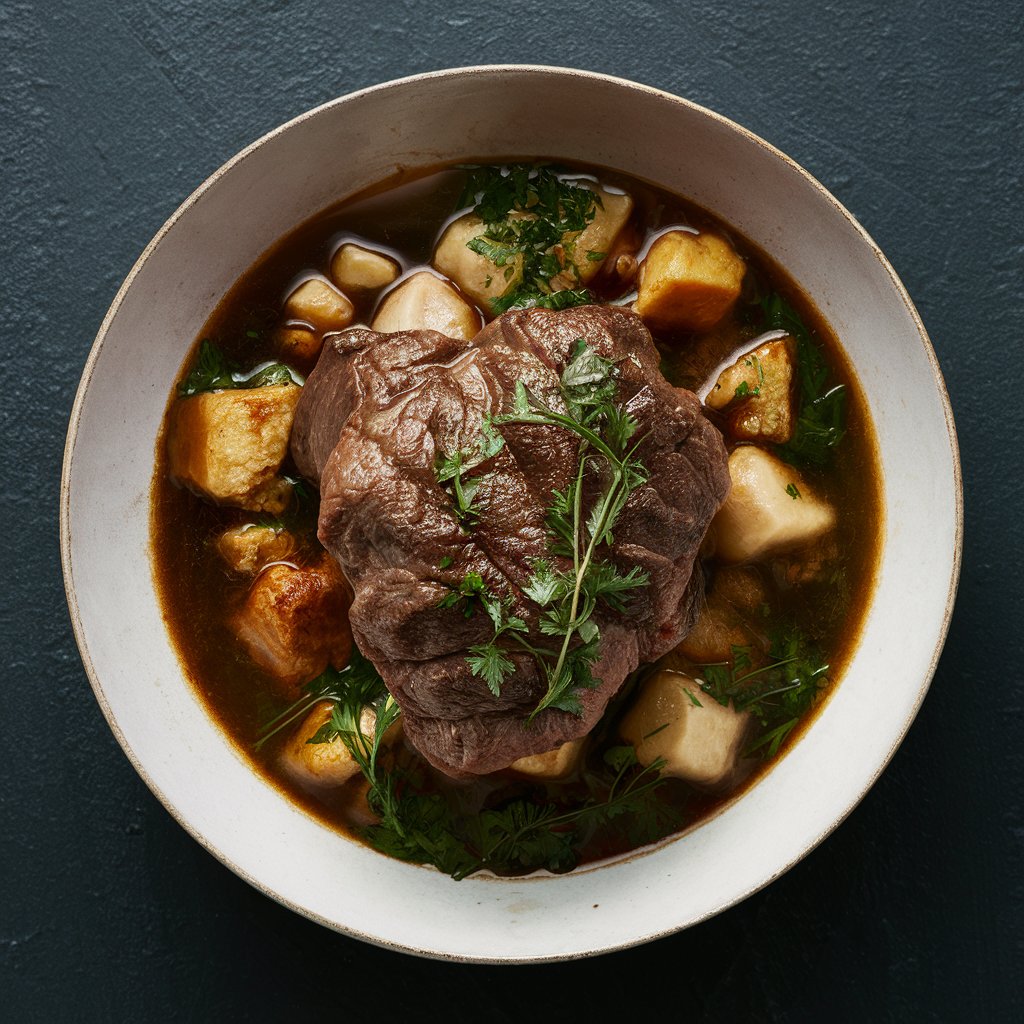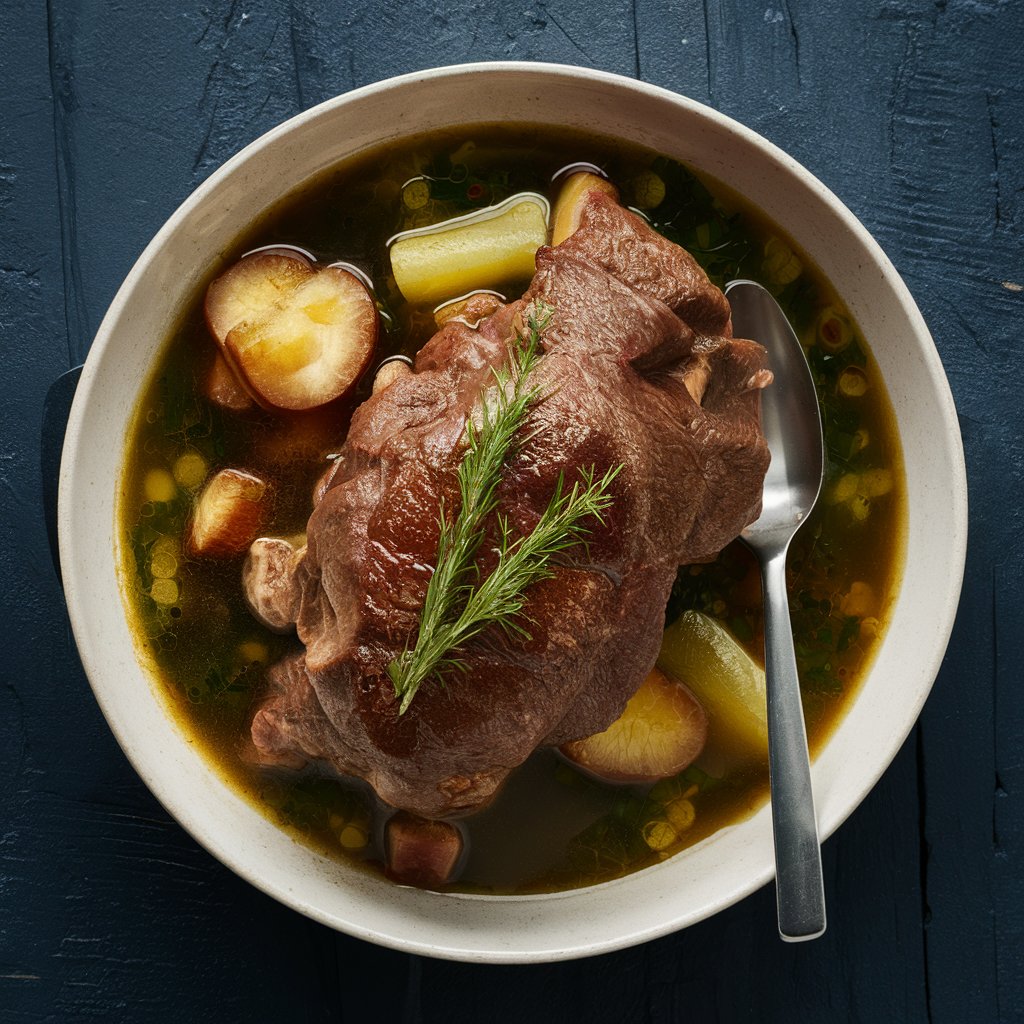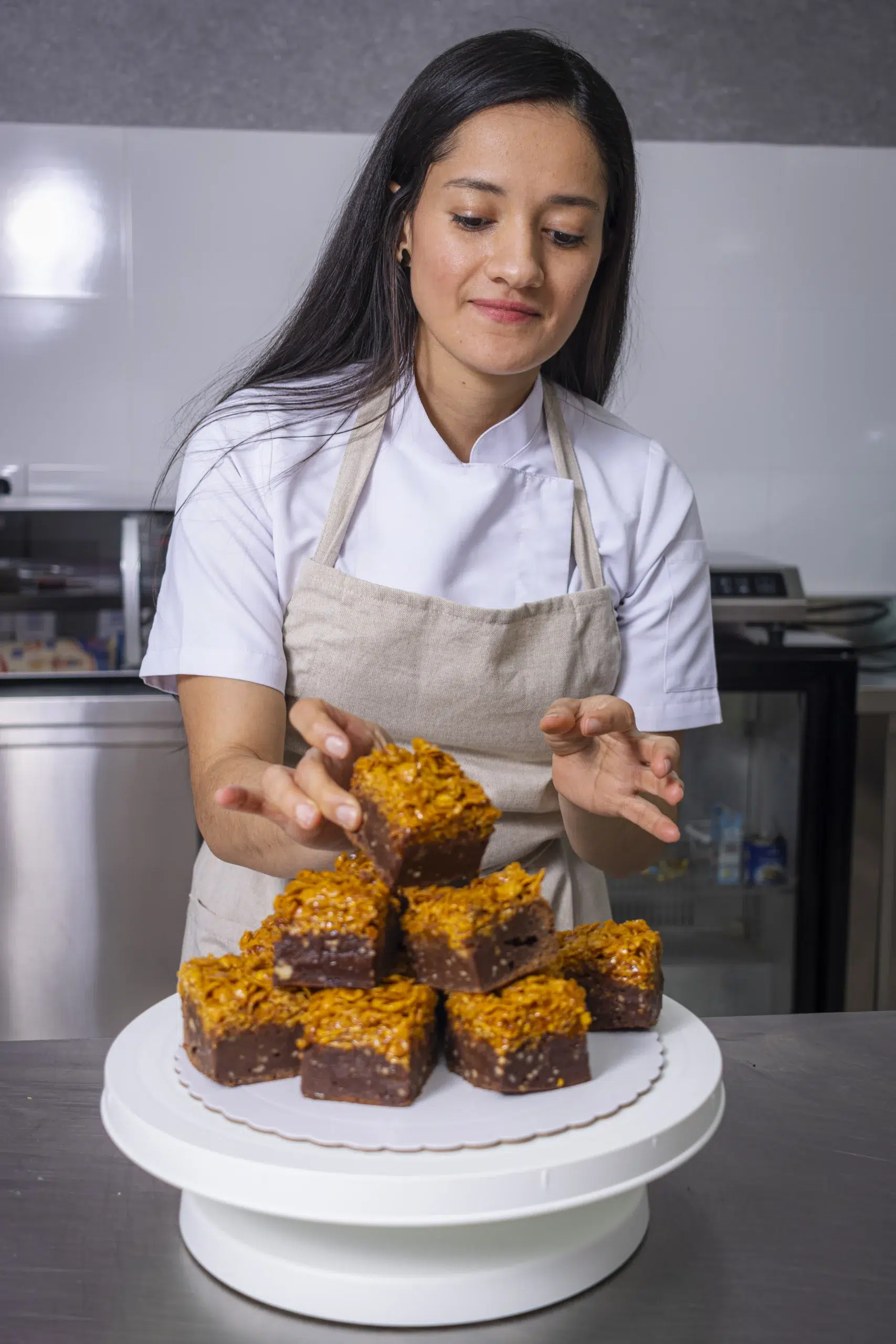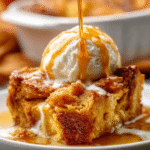Introduction to Cooking Beef Shank
What is Beef Shank?
Beef shank, derived from the leg of the cow, is known for its robust flavor and toughness due to its high connective tissue content. This cut is often used in slow-cooked dishes because of its ability to become incredibly tender when cooked properly. Rich in collagen, beef shank offers a depth of flavor that’s hard to match.
Why Choose Beef Shank?
Why opt for beef shank when there are so many other cuts? Well, beef shank is both affordable and incredibly flavorful. When cooked correctly, it provides a luxurious texture and taste that elevates any meal. Plus, it’s versatile – perfect for stews, soups, and braises. Despite its initial toughness, patience and proper cooking methods turn beef shank into a culinary masterpiece.
Factors Affecting Tenderness
Connective Tissue Breakdown
To achieve tender beef shank, understanding the role of connective tissue is crucial. Connective tissues, primarily collagen, need to break down during cooking. This breakdown happens effectively at low temperatures over extended periods, turning tough meat into a gelatinous, tender delicacy.
Importance of Low and Slow Cooking
Low and slow cooking is essential for beef shank. Methods like braising and slow cooking allow the collagen to convert into gelatin, which tenderizes the meat. This process cannot be rushed, as cooking at higher temperatures can result in dry, tough meat. Thus, patience is key when aiming for tender beef shank.
Marinating and Seasoning
Marinating beef shank before cooking can significantly enhance its tenderness and flavor. Using a marinade with acidic components like vinegar or citrus juice helps break down muscle fibers. Additionally, seasoning with herbs, garlic, and spices infuses the meat with rich, deep flavors.
Popular Cooking Methods for Tender Beef Shank
Braising
Braising is a tried-and-true method for cooking beef shank. Start by searing the meat to develop a rich crust, then slow-cook it in a liquid. This method combines dry and moist heat, making it perfect for breaking down tough cuts. Use beef broth, tomatoes, and a mix of aromatics like onions and garlic for a flavorful braise.
Slow Cooking
Using a slow cooker is another excellent way to achieve tender beef shank. This method is particularly convenient as it requires minimal effort. Simply place the seasoned shank in the slow cooker with your choice of liquid, set it on low, and let it cook for several hours. The result? Meat that falls off the bone effortlessly. For additional tips, check out this comprehensive guide on Which Cooking Method is Best for the Shanks.
Pressure Cooking
For those short on time, a pressure cooker can tenderize beef shank quickly. By cooking the meat under high pressure, the collagen breaks down faster, resulting in tender, juicy shank in a fraction of the time. However, be mindful of the cooking time to avoid overcooking.
Smoking
Combining smoking with braising adds a unique depth of flavor to beef shank. Smoke the shank for a couple of hours to infuse it with a smoky aroma, then finish it off by braising in a flavorful liquid. This method ensures both a tender texture and a rich, complex flavor profile.
Next, we’ll delve into detailed recipes for each cooking method, providing you with step-by-step instructions to achieve the perfect beef shank. Stay tuned for Part 2!
Detailed Recipes for Cooking Beef Shank
Braised Beef Shank Recipe
Ingredients Needed
- 3 lbs. cross-cut beef shanks (about 4 pieces)
- 2 tablespoons olive oil
- 2 medium onions, chopped
- 3 carrots, peeled and chopped
- 3 celery stalks, chopped
- 4 garlic cloves, minced
- 1 bay leaf
- 4 cups beef broth
- 1 teaspoon salt
- 1 teaspoon pepper
- Fresh thyme sprigs
Step-by-Step Instructions
- Prepare the Beef Shank: Pat the beef shanks dry with paper towels. Season generously with salt and pepper.
- Sear the Meat: In a large Dutch oven, heat the olive oil over medium-high heat. Sear the beef shanks on all sides until they are well-browned. This step is pivotal for developing deep flavors.
- Add Aromatics: Remove the shanks and set them aside. In the same pot, add onions, carrots, and celery. Sauté until the vegetables are softened, about 5- 7 twinkles.
- Deglaze the Pot: Add garlic and cook for another minute. Pour in a small amount of beef broth to deglaze the pot, scraping up any browned bits from the bottom. These bits add extra flavor.
- Braise the Shanks: Return the beef shanks to the pot. Add the bay leaf, thyme, and the remaining beef broth. Bring the mixture to a simmer.
- Cook Low and Slow: Cover the pot and transfer it to a preheated oven at 325°F (163°C). Cook for about 2-3 hours, or until the meat is fork-tender.
- Serve: Once cooked, remove the beef shanks and set them on a serving platter. Skim any excess fat from the braising liquid and serve it as a sauce over the shanks.
Tips for Best Results
- Ensure the beef shanks are completely submerged in the liquid to cook evenly.
- For an extra layer of flavor, add a splash of tomato sauce or Worcestershire sauce to the braising liquid.
Slow Cooker Beef Shank Recipe
Ingredients Needed
- 2 lbs. beef shanks
- 1 large onion, sliced
- 2 cups beef broth
- 1 cup diced tomatoes
- 2 cloves garlic, minced
- 1 teaspoon dried thyme
- 1 teaspoon dried rosemary
- Salt and pepper to taste
Step-by-Step Instructions
- Season and Sear: Season the beef shanks with salt and pepper. In a skillet, heat some oil and sear the shanks on all sides until browned.
- Prepare Slow Cooker: Place the sliced onions, garlic, thyme, and rosemary in the slow cooker.
- Add Shanks and Liquid: Place the seared beef shanks on top of the vegetables. Pour in the beef broth and diced tomatoes.
- Cook on Low: Set the slow cooker to low and cook for 8-10 hours. The beef shank should be tender and easily pull apart with a fork.
- Serve: Remove the beef shanks from the slow cooker and serve with the cooked vegetables and sauce.
Tips for Best Results
- For a richer flavor, use beef broth instead of water.
- Adding a tablespoon of soy sauce can enhance the umami flavor of the dish.
Pressure Cooker Beef Shank Recipe
Ingredients Needed
- 2 lbs. beef shanks
- 1 onion, chopped
- 2 carrots, chopped
- 2 celery stalks, chopped
- 2 cups beef broth
- 1 teaspoon salt
- 1 teaspoon pepper
- 2 cloves garlic, minced
Step-by-Step Instructions
- Season and Sear: Season the beef shanks with salt and pepper. Heat oil in the pressure cooker and sear the shanks on all sides.
- Add Vegetables: Remove the shanks and add onions, carrots, and celery to the pot. Sauté for a many twinkles until softened.
- Add Shanks and Broth: Return the shanks to the pot and add the garlic and beef broth.
- Pressure Cook: Seal the pressure cooker and cook on high pressure for 50 minutes. Allow the pressure to release naturally.
- Serve: Once the pressure is released, remove the lid and transfer the shanks to a serving dish. Strain the liquid if desired and serve as a sauce.
Tips for Best Results
- Ensure the pressure cooker is properly sealed to maintain high pressure.
- Let the meat rest for a few minutes before serving to absorb the juices fully.
Smoked Beef Shank Recipe
Ingredients Needed
- 1 whole beef shank (4-5 lbs.)
- 4 tablespoons beef seasoning
- 2 cups beef broth
- 1 cup water
- 1 onion, sliced
- 1 sprig rosemary
Step-by-Step Instructions
- Season and Prepare: Rub the beef shank with your choice of beef seasoning.
- Smoke the Shank: Preheat the smoker to 250°F (121°C). Smoke the shank for 2 hours to infuse it with smoky flavor.
- Prepare to Braise: After smoking, place the shank in a Dutch oven. Add beef broth, water, sliced onion, and rosemary.
- Braise in Oven: Cover the pot and place it in a preheated oven at 300°F (149°C). Cook for 3- 4 hours until the meat is tender.
- Serve: Remove the shank from the pot and serve with the braising liquid.
Tips for Best Results
- Use a combination of hardwoods like oak and cherry for a balanced smoky flavor.
- Ensure the shank is well-seasoned before smoking to enhance the taste.
Stay tuned for Part 3, where we’ll discuss how to serve beef shank with various accompaniments to make your meal complete!

How to Serve Beef Shank
Accompaniments
Beef shank, with its rich and robust flavor, pairs beautifully with a variety of side dishes. Choosing the right accompaniments can elevate your meal, making it even more satisfying and well-rounded. Here are some classic and creative sides to serve with your tender beef shank.
Mashed Potatoes
- Creamy mashed potatoes are a classic choice. Their smooth texture complements the tender, juicy beef shank perfectly. You can enhance the flavor by adding garlic or cheese to the mashed potatoes.
Polenta
- Another excellent option is polenta, which provides a soft, creamy base for the beef shank. The mild flavor of polenta allows the rich taste of the beef to shine.
Steamed Vegetables
- For a lighter side, consider steamed vegetables like broccoli, carrots, or green beans. These add a fresh, crisp contrast to the hearty beef.
Rice or Risotto
- Rice, especially a creamy risotto, is a wonderful side that can absorb the flavorful juices from the beef shank.
Roasted Root Vegetables
- Roasting vegetables like potatoes, carrots, and parsnips with some herbs and olive oil creates a flavorful and hearty side that pairs well with beef shank.
Garnishes and Final Touches
Adding the right garnishes can enhance both the presentation and flavor of your beef shank dish.
Fresh Herbs
- Sprinkle fresh herbs like parsley, thyme, or rosemary over the dish just before serving. This adds a burst of freshness and color.
Gremolata
- Gremolata, a mixture of lemon zest, garlic, and parsley, can be sprinkled on top of the beef shank. This Italian condiment adds a zesty, vibrant flavor that contrasts nicely with the rich meat.
Sauce
- Drizzle the braising liquid or a reduction of it over the beef shank. This not only adds moisture but also intensifies the dish’s flavors.
Storage and Reheating Tips
Properly storing and reheating beef shank ensures you can enjoy leftovers without compromising taste or texture.
Storage
- Allow the beef shank to cool completely before storing. Place it in an watertight vessel and chill for over to 3- 4 days. For longer storage, you can freeze the beef shank for up to 3 months.
Reheating
-
When reheating, do so gently to avoid drying out the meat. Reheat in a covered dish in the oven at a low temperature (around 300°F or 150°C) until warmed through. Alternatively, you can reheat it on the stovetop over low heat, adding a bit of broth to keep it moist.
Next, we’ll address some frequently asked questions about cooking beef shank, providing you with additional tips and tricks to perfect this dish. Stay tuned for Part 4!

Frequently Asked Questions (FAQs) About Cooking Beef Shank
How Long Does Beef Shank Take to Get Tender?.
Achieving tender beef shank typically requires a cooking time of 2 to 3 hours when braised or cooked on the stovetop. If using a slow cooker, it can take between 8 to 10 hours on low heat. For pressure cooking, it usually takes about 50 minutes under high pressure.
What Are the Best Liquids for Braising?
Braising beef shank can be done with various liquids to enhance flavor. Beef broth is a popular choice, but you can also use vegetable broth, tomato sauce, or a mixture of broth and tomato paste. Adding aromatics like onions, garlic, and herbs to the braising liquid will further enrich the dish.
Can You Overcook Beef Shank?
While it’s hard to overcook beef shank due to its high collagen content, cooking it at too high a temperature can make the meat dry and less flavorful. The key is to cook it “low and slow” to allow the collagen to break down into gelatin, making the meat tender and juicy.
How Can You Add More Flavor to Beef Shank?
To boost the flavor of beef shank, marinate it overnight with herbs, garlic, and acidic ingredients like lemon juice. During cooking, adding a bouquet garni (a bundle of herbs) to the pot can impart additional depth. Using a rich beef broth and incorporating root vegetables will also enhance the flavor profile.
What Side Dishes Pair Well with Beef Shank?
Can You Freeze Cooked Beef Shank?
Yes, cooked beef shank can be frozen for up to 3 months. To freeze, let the meat cool completely, then portion it into airtight containers or heavy-duty freezer bags. When ready to eat, thaw the beef shank in the refrigerator overnight and reheat it gently in the oven or on the stovetop.
What Are Some Popular Recipes for Cooking Beef Shank?
Popular recipes for beef shank include braised beef shank, slow-cooked beef shank, and beef shank stew. Each of these methods highlights the meat’s potential for tenderness and rich flavor when cooked properly. Another well-loved dish is Osso Buco, which is typically made with veal shanks but can also be made with beef shanks for a heartier version.
Can You Cook Beef Shank Without Using Alcohol?
Absolutely! If you prefer not to use alcohol in your cooking, substitute wine with beef broth or tomato juice. These alternatives provide the necessary liquid for braising while adding their own unique flavors.
How Should I Store Raw Beef Shank?
Store raw beef shank in the refrigerator in its original packaging or in an airtight container. Use it within a many days of purchase for the stylish quality.
If you need to store it longer, freezing is an option. Wrap the beef shank tightly in plastic wrap and foil or place it in a freezer bag, and it will keep for several months.
Can You Use Beef Shank in Soups and Stews?
Yes, beef shank is excellent in soups and stews. Its high collagen content releases during slow cooking, adding body and richness to the broth. It’s perfect for hearty dishes like beef shank stew or a flavorful beef and vegetable soup.
In the next part, we’ll wrap up with some final thoughts and encourage you to try your hand at cooking beef shank. Stay tuned for Part 5!
Final Thoughts on Cooking Beef Shank
Recap of Key Points
Cooking beef shank to tender perfection involves patience and the right techniques. Understanding the role of connective tissue, utilizing low and slow cooking methods, and adding flavorful liquids and aromatics are essential steps. Whether you choose to braise, slow cook, pressure cook, or smoke the beef shank, each method can produce a delicious and tender dish with the right approach.
Encouragement to Try Cooking Beef Shank
Don’t let the initial toughness of Beef Shank intimidate you. With the knowledge and recipes provided, you’re well-equipped to turn this affordable and flavorful cut into a culinary delight. Trial with different cuisine styles and flavor combinations to find what works best for you.
The rewards of a perfectly cooked beef shank—tender, juicy, and rich with flavor—are well worth the effort.
By now, you should feel confident in your ability to cook beef shank to perfection. Gather your ingredients, choose your cooking method, and enjoy the process of transforming a tough cut of meat into a tender, mouth-watering dish. Happy cooking!
This concludes our comprehensive guide on cooking beef shank. Whether you’re a seasoned cook or a beginner, these tips and recipes are designed to help you achieve delicious results. For more information on the science behind collagen and slow cooking, check out this Serious Eats article. To learn more about braising techniques, visit The Spruce Eats. And for additional braising basics, see this guide from Food Network.









